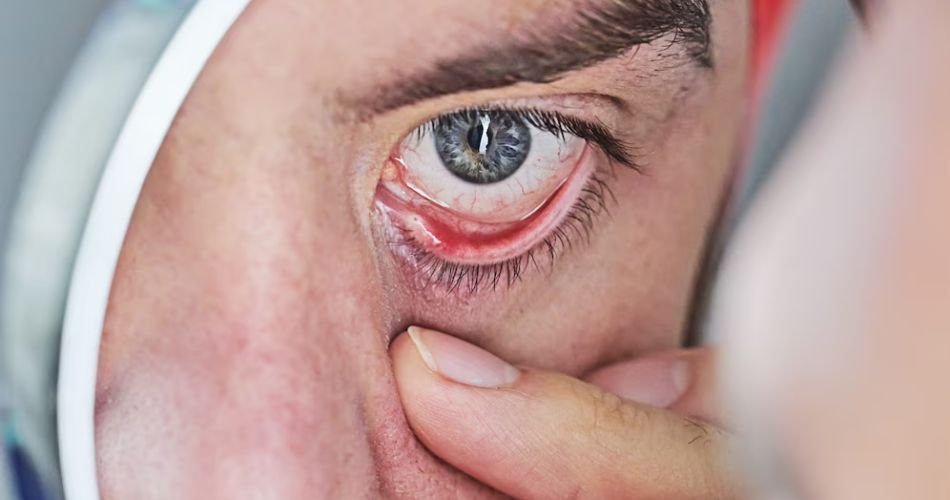The clear conjunctiva is a vital sign of healthy eyes, representing a thin, transparent layer that protects and lubricates the exposed parts of the eyeball and the inner surface of the eyelids. When the conjunctiva is healthy, it is barely noticeable because it remains transparent and moist, helping to maintain a comfortable vision experience. Any changes in its clarity, such as redness, cloudiness, or swelling, can immediately alert us to underlying problems. Keeping the conjunctiva clear is not just about aesthetics but about maintaining overall eye health, preventing infections, reducing irritation, and ensuring that our vision remains sharp and unobstructed throughout our lives.
Anatomy and Function of the Conjunctiva
The conjunctiva is divided into three parts, the palpebral conjunctiva, which lines the eyelids; the bulbar conjunctiva, which covers the white part of the eyeball; and the fornix, where the bulbar and palpebral conjunctivas meet. Its primary functions include acting as a protective barrier against dust, debris, and microorganisms, while also playing a significant role in producing mucus and tears that lubricate the eye. Without a clear conjunctiva, the surface of the eye would be vulnerable to injury and infection, and our ability to see comfortably would be compromised.
What Does a Clear Conjunctiva Indicate
A clear conjunctiva is an indication of healthy, well-moisturized eyes that are free from inflammation, infection, or allergic reactions. It shows that the tear film is functioning properly, creating a smooth optical surface for clear vision. The absence of redness or swelling implies that blood vessels within the conjunctiva are not inflamed, and there is no immune response underway to fight infection or irritation. In simple terms, a clear conjunctiva means your eyes are healthy, balanced, and working exactly as they should be, quietly performing their daily tasks without drawing attention to themselves.
Common Issues Affecting Conjunctival Clarity
Several conditions can cause the conjunctiva to lose its clarity, leading to discomfort, visual disturbances, or the appearance of redness and swelling. Conjunctivitis, often called “pink eye,” is one of the most common problems, usually caused by bacterial or viral infections. Allergic conjunctivitis, triggered by allergens like pollen or pet dander, can also inflame the conjunctiva. Dry eye syndrome, resulting from inadequate tear production, can leave the conjunctiva dry and irritated. Even irritants like smoke, chlorine in pools, or prolonged exposure to wind can lead to temporary cloudiness and discomfort.
Environmental Factors Influencing Conjunctival Health
Our environment plays a critical role in the health of our conjunctiva. Exposure to pollutants, smoke, strong winds, dry air, and allergens can all compromise the conjunctiva’s clarity. Seasonal allergies in the spring and fall can cause allergic conjunctivitis, making the eyes red and itchy. Urban environments, where air pollution is high, can also contribute to chronic eye irritation. Individuals who work in dusty or chemical-laden environments are at an increased risk of conjunctival irritation. Protecting your eyes with glasses or goggles and ensuring proper indoor air quality with humidifiers can significantly help maintain a clear conjunctiva.
Personal Habits That Impact the Clear Conjunctiva
Personal habits play a vital role in maintaining or compromising conjunctival clarity. Poor hygiene, such as rubbing your eyes with dirty hands, can introduce bacteria and viruses directly onto the conjunctival surface, leading to infections. Contact lens wearers who fail to properly clean or replace their lenses risk developing microbial infections that cloud the conjunctiva. Smoking is another major factor that contributes to eye irritation, causing chronic redness and dryness. Practicing good hygiene, properly managing contact lenses, quitting smoking, and maintaining a clean environment can go a long way in preserving the clarity of the conjunctiva.
Importance of Hydration for Conjunctival Clarity
Hydration is not just vital for your skin or internal organs—it’s also crucial for your eyes. The conjunctiva relies on an adequate supply of tears to stay moist and clear. Dehydration can lead to dry eye syndrome, causing the conjunctiva to become red, irritated, and less transparent. Drinking sufficient water daily, using lubricating eye drops when necessary, and avoiding overly dry environments can help keep the conjunctiva healthy. Staying hydrated ensures that the tear film remains stable, nourishing the conjunctiva and protecting it from environmental irritants.
Nutrition and Clear Conjunctiva
A nutrient-rich diet can have a profound impact on the clarity of the conjunctiva. Vitamins A, C, and E, along with minerals like zinc and essential fatty acids like omega-3s, are vital for maintaining the health of the eye’s surface. Vitamin A, in particular, plays a crucial role in mucous membrane health, directly impacting the conjunctiva. Foods such as carrots, spinach, sweet potatoes, citrus fruits, nuts, seeds, and fish are excellent for eye health. A diet lacking in these nutrients can make the conjunctiva more susceptible to dryness, infection, and inflammation.
Role of Eye Hygiene in Maintaining Clear Conjunctiva
Keeping the eyes clean is fundamental to maintaining conjunctival clarity. Washing your face and hands regularly, removing makeup before sleep, and avoiding touching or rubbing the eyes can prevent the introduction of irritants and infectious agents. For those who wear makeup, ensuring that eye cosmetics are not expired and applying them carefully to avoid getting particles into the eye is critical. Contact lens users must strictly adhere to hygiene protocols, including proper storage and timely replacement. Regular cleaning reduces the risk of infection and ensures the conjunctiva remains clear and healthy.
Screen Time and Its Effect on the Conjunctiva
In today’s digital age, extended screen time has become a major cause of conjunctival problems. When we stare at screens, our blink rate drops dramatically, leading to less frequent lubrication of the conjunctiva. This can cause dry eye symptoms and lead to a cloudy or irritated conjunctiva. Following the 20-20-20 rule—taking a 20-second break to look at something 20 feet away every 20 minutes—can help maintain natural blinking and reduce strain. Adjusting screen brightness, ensuring proper lighting, and using anti-glare screens are additional ways to protect the conjunctiva while working on digital devices.
Protection Against External Threats
Protecting your eyes from external threats such as UV rays, wind, dust, and chemicals is essential for maintaining a clear conjunctiva. Sunglasses that block 100% of UVA and UVB rays are a must when outdoors. When engaging in activities like swimming, wearing protective goggles can prevent exposure to chlorine and other pool chemicals. Similarly, if you work in environments where your eyes are exposed to irritants or chemicals, using appropriate safety glasses can prevent damage to the conjunctiva and keep it clear and healthy.
Signs of Conjunctival Problems to Watch For
It’s important to monitor the health of your eyes and recognize early signs of conjunctival issues. Persistent redness, swelling, excessive tearing, discharge, foreign body sensation, or pain should not be ignored. These symptoms could indicate an infection, allergic reaction, or dry eye syndrome. Early detection allows for prompt treatment, preventing minor issues from developing into more serious conditions that could affect vision. Regular eye checkups can also help detect hidden problems early and keep your conjunctiva and overall eye health in excellent condition.
Medical Treatments for Conjunctival Issues
When conjunctival issues arise, various treatments are available depending on the underlying cause. Bacterial conjunctivitis often requires antibiotic eye drops, while viral conjunctivitis typically resolves on its own but may require supportive care. Allergic conjunctivitis can be managed with antihistamines or anti-inflammatory eye drops. For dry eyes, artificial tears and sometimes prescription medications like cyclosporine drops are used to increase tear production and reduce inflammation. In more severe cases, medical procedures like punctal plugs may be necessary to help retain moisture on the eye’s surface.
Natural Remedies for Clear Conjunctiva
In addition to medical treatments, several natural remedies can support conjunctival health. Applying a cold compress to the eyes can reduce swelling and redness. Chamomile tea bags, cooled and placed over the closed eyes, can provide soothing relief for irritation. Proper hydration, a healthy diet, and practicing stress management techniques like meditation can also help maintain overall eye health. While natural remedies can be effective for mild symptoms, they should not replace professional medical advice when dealing with more serious conditions.
Conclusion
Maintaining a clear conjunctiva is essential for overall eye health and comfort. By understanding the factors that impact conjunctival clarity, practicing good hygiene, protecting the eyes from environmental threats, maintaining hydration, and ensuring a nutrient-rich diet, you can preserve the health of your conjunctiva for the long term. Regular eye checkups and prompt attention to any signs of trouble are also crucial steps in ensuring your eyes remain healthy and your vision stays sharp. The conjunctiva might be a thin, nearly invisible layer, but its role in your eye health is massive—so take good care of it.




